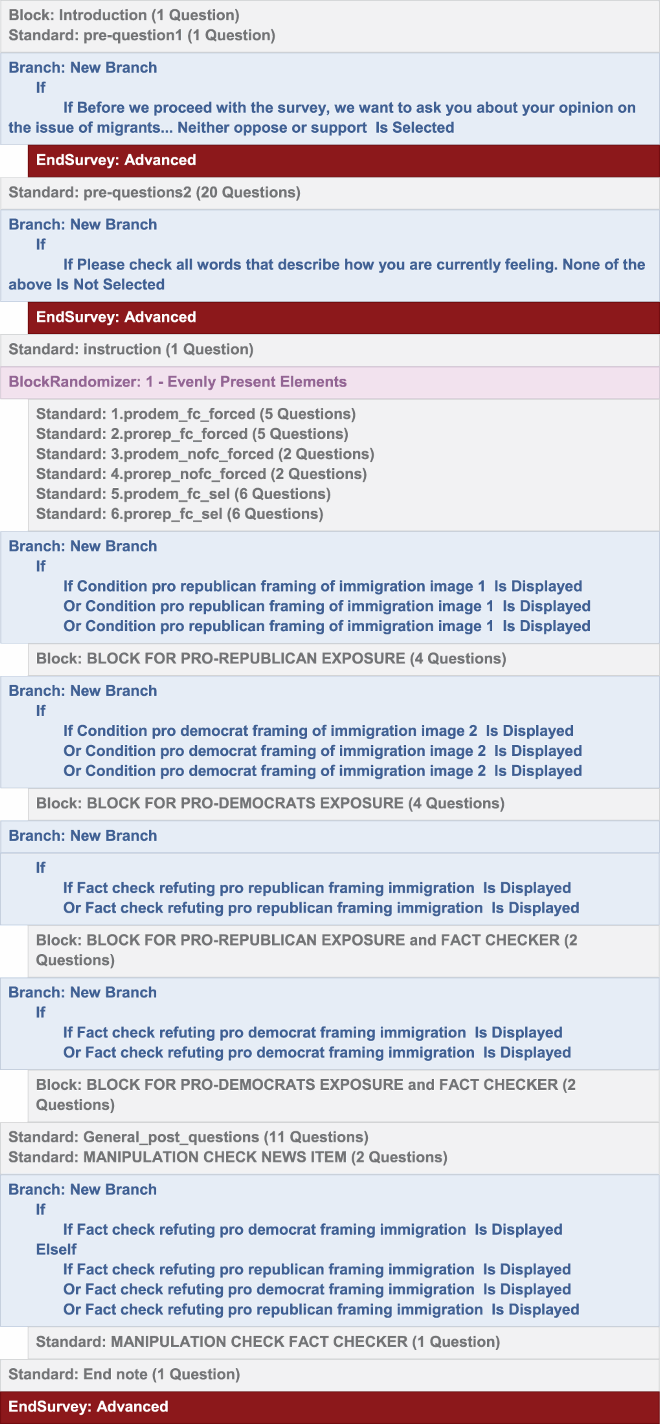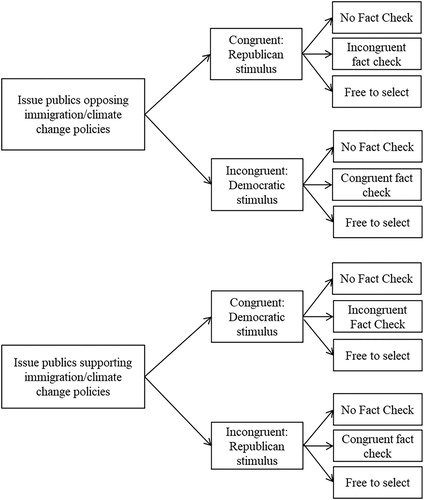ABSTRACT
In today’s media environment, the flow of incoming information can be overwhelming. Citizens are exposed to both congruent and incongruent information, following each other at a fast pace. At the same time, citizens have the freedom to compose their own daily information diet. This demanding and personalized media environment plays a decisive role in political decision-making. One crucial political evaluation is to assign credit or blame to politicians. In this setting of selective exposure and motivated reasoning, we conducted two experiments (N = 1,117) to test how forced versus selective exposure to mixed congruent-incongruent news articles and fact checkers on immigration (Study 1) or climate change (Study 2) affects citizens’ evaluations of responsibility. The key findings expand extant research that identified partisan biases in citizens’ responsibility perceptions: People select and process partisan information in a biased way to reassure partisan identities. A key democratic implication is the prevalence of citizens’ defensive motivation when assigning responsibility.
In times of information overload, people are frequently confronted with conflicting messages, or information that is first presented as true but later argued to be inaccurate or ‘fake’ in nature (Van Aelst et al., Citation2017). One example of such mixed exposure is the recent surge of fact-checkers as an online journalistic instrument to test the claims made in political communication (e.g., Thorson, Citation2016). In that sense, fact checkers that debunk claims made in news items offer a relevant case study to understand how citizens evaluate mixed congruent and incongruent news. Against this backdrop, the central aim of this paper is to investigate how people select and respond to mixed reassuring and attacking political information in their daily online media environment.
In order to arrive at informed political decisions, citizens have to navigate through the vast supply of congruent and incongruent information, for example when they assign blame. Representative democracy is for a large part founded on the principle of accountability. Citizens have to evaluate politicians and reward or punish them at the ballot box (Gomez & Wilson, Citation2008). To do so, they need to know who is responsible for failures, and who is accountable for successes. Citizens’ blame perceptions are often guided by heuristic cues, for example offered in media content (e.g., Iyengar, Citation1991). Based on the mechanism of motivated reasoning, it can be argued that incoming information on blame is judged on its fit with citizens’ prior attitudes (e.g., Taber & Lodge, Citation2006). Research on responsibility attributions provides evidence for such attitudinal lenses. Specifically, citizens are most likely to accept blame attributions to the government if they have negative attitudes towards the ruling elites. When they are closer to the government, in contrast, they are more likely to absolve it of blame (Tilley & Hobolt, Citation2011). Moreover, in the polarized political climate of the US, it is demonstrated that although opposing partisans may have accurate beliefs about facts, they still interpret these facts in line with their partisan lenses (Gaines, Kuklinski, Quirk, Peyton, & Verkuilen, Citation2007).
Assigning blame in response to mixed congruent and incongruent political news might be driven by citizens’ patterns of information selection and avoidance. Accordingly, selective exposure may augment in-group serving biases (Iyengar & Hahn, Citation2009). Citizens are nowadays more in charge of their own media diet, selectively exposing themselves to like-minded political content whenever and wherever they prefer or avoiding political content altogether. This raises important democratic concerns: in the context of mixed political news, do citizens accept attacking information when it rejects the message presented in a first attitude-congruent online news article? And how do selective exposure and attitudinal congruence condition the effects of mixed political news on assignment of responsibility?
To answer these questions, we rely on two experiments conducted in the US. We first of all test how attitudinal congruence of news on immigration (Study 1) and climate change (Study 2) drives the selection of a second article with a contradicting stance on the issue (i.e., a debunking fact checker). Second, we investigate the role of motivated reasoning in the effects of such news on partisans’ evaluation of causal responsibility (Study 1) and treatment responsibility (Study 2). The results provide important insights into the guiding influence of selection, avoidance, and partisan identification on citizens’ evaluations of responsibility in the current high-choice online media setting. Do they fight off attacks, or do they run away from it altogether?
The effects of partisan political news and counter-attitudinal attacks
In a time of increasing levels of information overload, people are exposed to a great variety and frequency of political content at relatively short amounts of time (e.g., Van Aelst et al., Citation2017). Hence, on a daily basis, people are confronted with both congruent and incongruent pieces of information that follow up on each other in a fast pace. Citizens may not always be active in avoiding attacks on their prior held beliefs (Garrett, Citation2009), for example because they do not always have the motivation and ability to avoid or resist attacks on their prior attitudes. In this setting, it has been argued that the persuasiveness of incongruent political communication depends on the strength of people’s perceptual screens or partisan biases (e.g., Nyhan & Reifler, Citation2010). Gaines et al. (Citation2007) for example demonstrate that although partisans hold the same accurate beliefs about facts, they interpret these facts in a way that supports their partisan identity. If facts hurt the Republican party, for example, Republicans may interpret them in a way that absolves their partisan in-group of blame.
Information that is regarded as ‘true’ today can be contested tomorrow. In this setting, exposure to congruent and incongruent political communication on the same issue frequently presents itself in the form of political fact checkers that follow-up partisan communication (Thorson, Citation2016). Fact checkers test the claims made in political messages, typically relying on thorough evidence-based evaluations of all claims made in political speeches, news stories or other forms of communication (Thorson, Citation2016). Although these corrective attempts can be effective, misinformation can be hard to correct if it resonates with strongly held beliefs about politics and society (e.g., Thorson, Citation2016). It may thus be crucial to assess how partisans cope with this mixed media environment, where people’s prior attitudes are both confirmed by congruent political news and attacked by incongruent news, such as political fact checkers.
Citizens use heuristic tools to navigate through the potential exposure moments offered to them. Specifically, incoming information is subject to an attitudinal filter, for example based on ideology or partisanship (e.g., Druckman & Bolsen, Citation2011; Taber & Lodge, Citation2006). This filtering mechanism can be explained in the light of individuals’ intrinsic desire to avoid cognitive dissonance (Taber & Lodge, Citation2006). Indeed, in line with the principle of motivated reasoning, new information is evaluated in congruence with prior held beliefs (Taber & Lodge, Citation2006). This means that information that supports already held beliefs is seen as more credible and reliable than unsupportive information because such information reassures a consistent self-image (Taber & Lodge, Citation2006). Disconfirming information is likely to be received with doubt and skepticism or is even actively counter-argued (Druckman & Bolsen, Citation2011). But what happens if people are confronted with political news that attacks their already held beliefs?
We expect that, in the highly polarized setting of the US, partisan identities play a key role in filtering out incongruent claims (e.g., Iyengar & Hahn, Citation2009). In line with this, the process of affective polarization postulates that partisan identities play a key role in how individuals experience belonging to an in-group of fellow partisans (Iyengar & Westwood, Citation2015). This means that people who identify with the Republican party have a more positive evaluation of fellow party members, and a more negative evaluation of members of the other party (e.g., Iyengar & Westwood, Citation2015). A consequence of this is that congruent articles that affirm partisan identities should be uncritically accepted whereas attacks on partisans’ identities should result in a bolstering of prior attitudes (e.g., Taber & Lodge, Citation2006). When prior held partisan beliefs are attacked by incongruent news stories, partisans’ defensive motivation is triggered (e.g., Hart et al., Citation2009).
Evaluating blame in response to partisan political news and retractions
The functioning of representative democracy is for a large part based on the extent to which citizens are able to assign responsibility in an accurate and well-informed way (Malhotra & Kuo, Citation2008). This means that citizens have to punish political actors for failures and credit them for successes (Gomez & Wilson, Citation2008; Malhotra & Kuo, Citation2008; Tilley & Hobolt, Citation2011). As they oftentimes lack factual information as an input for responsibility attributions, citizens rely heavily on heuristic cues in their information environment (e.g., Hobolt & Tilley, Citation2014). The media provide an influential and easily accessible source of such cues (e.g., Iyengar, Citation1991). As partisan cues simplify complex political issues into a binary divide of the ‘good’ us and the ‘culpable’ others, they can steer political attitudes by cultivating social identity whilst assigning blame to actors external to the individual.
In light of polarization as a consequence of exposure to mixed congruent and incongruent partisan political news, it can be expected that citizens are guided by their partisan identities in their assignment of responsibility (Hobolt & Tilley, Citation2014). Hence, to avoid cognitive dissonance, partisans are less likely to attribute blame to their own party and more likely to assign blame to their disliked party (Taber & Lodge, Citation2006). In response to incongruent political news, partisans should defend their party by resisting persuasion when a news article blames ‘their’ party. Partisans should thus stick to their guns by defending their priors when they are under full attack (Druckman & Bolsen, Citation2011).
In the current online media environment, fact checkers can present such an attack on partisans’ political attitudes (e.g., Thorson, Citation2016). By offering a rebuttal of claims made in a political news story, they can present partisans with either a congruent or incongruent cue. If a fact checker refutes the claims of an attitudinally congruent news story, it can be regarded as mixed information and therewith an attack on partisans’ priors, which should motivate them to defend their priors (e.g., Hart et al., Citation2009). But are people actually willing to select information that attacks their prior attitudes in the first place?
Selective exposure and avoidance to attacks on congruent and incongruent news
Although it has been argued that partisans do not always actively avoid challenging information (e.g., Garrett, Citation2009), they do have the tendency to prefer reassuring claims over disconfirming evidence (e.g., Stroud, Citation2008). This phenomenon has been termed selective exposure (e.g., Bennett & Iyengar, Citation2008; Stroud, Citation2008) or selective avoidance (e.g., Garrett, Citation2009; Van Aelst et al., Citation2017). Selective exposure describes the phenomenon by which citizens tend to prefer information and sources that are in line with their prior held beliefs, whereas they are more likely to avoid information and sources that are not in line with their priors (e.g., Iyengar & Hahn, Citation2009). These selection activities might result in a confirmation bias where audiences restrict themselves to information that aligns with preexisting attitudes, resulting in negative political and democratic consequences (Bennett & Iyengar, Citation2008). Thus, in the context of the perseverance of information overload and contradicting information, individuals may potentially create their own biased news environment where confirming prior beliefs outweighs factual correctness (e.g., Bennett & Iyengar, Citation2008). In sum, in today’s high-choice media setting, exposure to media content can no longer be assumed and might be depended on audiences’ attitudes. Hence, media effects only occur when people are exposed to messages and forced exposure has become a more rare event. For this reason, our experiments vary between forced and selective exposure.
In light of the desire to avoid cognitive dissonance, people are most likely to avoid incongruent views, reassuring their partisan identities and outweighing the need for correctness or a complete understanding (Taber & Lodge, Citation2006). In this setting, the first dependent variable of this study is selective exposure or avoidance. We specifically introduce the following hypothesis. H1: In a mixed-congruence media environment, partisans are likely to selectively avoid articles that attack their prior attitudes whereas they selectively expose themselves to articles that confirm their existing views.
Attributing Responsibility in High-choice Media Settings
Previous empirical research has indicated that patterns of selective exposure to like-minded news can foster polarized divides in society (Stroud, Citation2008; Taber & Lodge, Citation2006). This means that incongruent information is avoided, refuted or counter-argued whereas congruent information is likely to be selected and uncritically accepted (Druckman & Bolsen, Citation2011). A potential political consequence of selective exposure is attitude polarization (Bisgaard, Citation2015; Stroud, Citation2008). Indeed, Bisgaard (Citation2015) demonstrates that partisans may base their political judgments on the same facts, they use these facts selectively to absolve their own party of blame, or to strengthen their perceptions that the other party should be held accountable. Due to patterns of selective exposure, partisans mainly see information that confirms their already held beliefs. Because such information is congruent with their priors, they are more likely to accept it, strengthening their partisan views (Stroud, Citation2008; Taber & Lodge, Citation2006).
Against this backdrop, we predict that partisans’ blame perceptions are not affected by counter-attitudinal information offered by fact checkers that attack congruent news (H2). When the attack on partisans’ priors is mitigated and dealt with by the congruent information in the fact checker, they should lower their guards as the need for defensive reasoning becomes less pressing. Therefore, we hypothesize that exposure to a congruent fact checker following counter-attitudinal partisan news results in a milder evaluation of blame (H3).
Finally, in the light of the polarizing potential of selection biases, and the influence of partisan lenses in attributing blame, it can be expected that partisans select or avoid fact checkers in a strategic way (Taber & Lodge, Citation2006). Hence, they should use the information presented in the selected fact checker to either confirm their priors or to bolster their resistance: Selective exposure to congruent fact checkers augments partisans’ prior attitudes (H4).
Method
Design of the experiments
Both experiments rely on a similar 2 (Partisan framing of the first article: Democrat versus Republican) × 3 (Exposure to a second attacking article: forced exposure to fact checker versus no exposure to a fact checker versus freedom to select a fact checker) between-subject factorial design. The freedom to select condition resulted in two additional groups, depending on whether participants self-selected or avoided the fact checker after seeing its headline. The first experiment was situated in the setting of online partisan news on immigration, and the second study presented participants with partisan news on climate change policies. The issues were selected as they are two polarized issues highly visible in public opinion. Immigration resonates with nativist/exclusionist identity, an issue mainly owned by the right-wing. Climate change, however, is an issue that may transcend national borders. This issue may be regarded as owned by the left, rather than the right-wing of the political spectrum. The attitudinal congruence of the partisan framing of the news article was assessed pre-exposure: participants were randomly assigned to news exposure that supported their attitudinal stance or opposed their stance at the issue at hand.
Samples
Both experiments rely on a quota sample of US citizens recruited from Amazon Mechanical Turk (MT). People were offered a financial incentive for their cooperation. The first study was completed by 550 participants. 881 people accessed the online survey link, which results in a completion rate of 62.4%. This sample of eligible participants had to pass a pre-treatment attention check item, which is crucial for online experimental studies that depend on actual exposure to the treatment. Hence, we can only assess the actual effect of the independent variables on the outcome variables if participants are willing and able to read a text. 85% passed the attention check. The final sample reflects national representativeness on gender, age, education and political orientation. Specifically, 49.1% of the sample was female, the mean age was 37.47 (SD = 11.39). The education level was distributed across three groups: lower (36.2%), moderate (47.8%) and higher (16.0%). Regarding partisan identities, the sample is close to representative polling data (Gallup, Citation2016): 33.1% felt close to the Independents, 30.2% to the Republicans and 36.7% to the Democratic party. We used quotas on partisan issue positions to ensure a more balanced sample distribution than the overall Mechanical Turk database (84 respondents with moderate attitudes were excluded from the survey). These quotas were enforced to create equally sized ‘issue publics’ on immigration and climate change policies. Study 2 followed exactly the same sampling procedures. In this study, 567 out of the 1,221 participants completed the full survey, corresponding to a completion rate of 46.4%. In this study, 78% passed the attention check. In the second study, sample distributions are quite similar to the first study: 46.0% was female. The mean age was 37.37 (SD = 11.72). Education was distributed across three levels: lower (33.2%), moderate (48.5%) and higher (18.3%). 30.0% felt closest to the Independents, 32.8% to the Republicans and 37.2% to the Democratic party (87 respondents with moderate attitudes where excluded from the survey). The sample distributions do not differ significantly between the two studies, and both by and large reflect national representativeness.
Procedure
In both studies, the survey environment was accessed through a link posted on MTurk’s portal. The ethical consent procedure was completed first. Upon agreement, participants proceeded to the questions that tapped into their issue positions regarding immigration (Study 1) or climate change policies (Study 2). Both issue positions were measured on 7-point scales, anchored by 1 (completely disagree) to 7 (completely agree). The scores on these items divided people in issue-publics: either supporting or opposing the attitudinal stance introduced in the item. Specifically, people scoring 1 through 3 where seen as counter-attitudinal issue publics, and those scoring 5 through 7 where regarded as pro-attitudinal issue-publics. Moderates were excluded from the analyses.
After completing the issue-publics question, a general pre-treatment survey included questions on demographics, more extended issue attitudes on immigration (Study 1) or climate change (Study 2). Political and media attitudes were also included in this question block. Upon completion, participants were randomly assigned to one of the treatment conditions. This random assignment was geared towards equal groups on attitudinal congruence, meaning that quota for issue-publics reflected a 50:50 distribution on pro-attitudinal versus counter-attitudinal publics. Post-hoc randomization checks further confirmed that these groups were equal on age, gender, and level of education. After being exposed to the first partisan news article, depending on the conditions they were in, respondents were exposed to a fact checker that concluded that the information in the previous article was largely false. Respondents were either offered the choice to select the second congruent/incongruent fact check article (selective exposure conditions), forced to see a second article (forced exposure conditions), or did not see the second article at all. depicts the stepwise experimental design in a flow chart.
Independent variables and treatments
All participants were first of all exposed to an online news story framed along partisan lines. In Study 1, the attitudinal stance was manipulated to reflect either arguments in favour of the position of accepting immigrants and policies geared towards helping immigrants or against this position. The position in favour of helping migrants further attributed blame to the Republican party for misconduct on this issue, whereas the counter-attitudinal message blamed the Democrats for failure to look after their own people. In that sense, the article used partisan framing to reflect the issue position of either Republicans or Democrats (see Appendix A for conditions).
The second study relied on similar framing for the first partisan article on climate change policies. The pro-attitudinal partisan article framed climate change as the country’s top priority, emphasizing how immediate action is needed to counter the effects of global warming. The Republicans were blamed for refusing to acknowledge the priority of this issue, and for their denial of human interference. The counter-attitudinal article denies climate change as a ‘real’ issue, and attributed blame to the Democratic Party for prioritizing this issue, wasting money on a lost cause. All treatments were based on a mixture of templates from existing online news articles, without making references to source cues. All articles were kept identical besides the manipulation of the independent variables in the header and main body.
In all conditions containing exposure to a second article, a fact checker was shown. This fact checker systemically argued that all claims made in the previous article were incorrect. In the condition where participants could choice to see a fact checker it was already shown that the main conclusion was that the previous article was ‘mostly false’ before they would read the full second article. This procedure ensured that the first and second article showed contradicting content, simulating exposure to both congruent and incongruent information. For the first news article, no source cues were used (in order to avoid source bias of partisan news outlets) while PoltiCheck, a fictional fact checker website, was used as a source for the second article. This article checked the facts of the first article. The publication date of both articles was identical, but the fact checker was presented as a response to the news article (the fact checker was published several hours later).
Dependent variables
After exposure to the treatments, participants were asked to rate various actors and institutions on their causal and treatment responsibility regarding the issue of immigration (Study 1) and climate change policies (Study 2). In Study 1, we focused on blame perceptions toward the political actors Barack Obama, Donald Trump and Hillary Clinton. We included two responsibility measures with slightly different wordings, and the effects were similar across these dependent variables. In addition, participants were asked to rate the responsibility of immigrants. In Study 2, treatment responsibility was measured on a more institutionalized level. Here, the Democratic Party, the Republican Party, corporations and citizens were rated on the extent to which they carried responsibility in dealing with the issue of climate change.
Causal responsibility attributions were measured using the following item wordings: ‘Could you indicate to what extent you believe the following actors are responsible for problems related to immigration (Study 1) or global warming (Study 2)? (1 = not responsible at all, 7 = fully responsible)’. Treatment responsibility attributions were measured using the following item wording: ‘Could you also indicate to what extent you believe the following actors are responsible for offering solutions to deal with immigration (Study 1) or to fight global warming (Study 2)? (1 = not responsible at all, 7 = fully responsible)’
In the selective exposure conditions, the dependent variable was the self-selection of the fact-checker (i.e., headline and conclusion) that was introduced with the following item: ‘Thinking of your everyday life, would you, as a follow up, read the following fact-checker of the article you just read?’ (1 = no, 2 = yes, M = 1.30, SD = .46).
Measuring attitudinal congruent persuasion
To check whether the study’s assignment of issue publics on immigration and climate change was robust, we included an additional and more elaborate measure of attitudinal congruence of the immigration and climate change news item. First of all, a five-item measure of immigration attitudes (Cronbach’s α = .92, M = 3.96, SD = 1.74) correlated strongly with the attitudinal filter item used in Study 1 (r = .93, p < 0.001). Second, a six-item climate change attitudes measure (Cronbach’s α = .87, M = 4.52, SD = 2.03) also demonstrated a very strong correlation with the measure uses to divide people into issue publics on the topic of climate change policies (r = .932, p < 0.001).
Manipulation checks
In Study 1, the manipulations of pro- versus counter-attitudinal framing succeeded (F(1, 535) = 788.15, p < 0.001). This means that participants exposed to the pro-immigration treatments regarded the news story as containing significantly and substantially stronger references to a positive stance towards allowing migrants to enter (M = 6.05, SD = 1.13) compared to participants exposed to the counter-attitudinal treatments (M = 2.39, SD = 1.50). The manipulation of the second attacking article also succeeded (F(1,293) = 256.99, p < 0.001). People exposed to a second article that rebutted the claims of the first article were substantially and significantly more likely to see the second article as disconfirming the first article (M = 6.50, SD = 1.23) than those not exposed to an attack (M = 2.32, SD = 1.83). The manipulation check analyses of Study 2 indicate exactly the same pattern. All manipulations thus succeeded.
Results of study 1
Selective exposure and avoidance of fact checkers refuting partisan news on migration
We first of all hypothesized that partisans are inclined to selectively avoid fact checkers that attack their prior attitudes and to selectively expose themselves to fact checkers that support their existing views (H1). The results of the logistic regression model summarized in provide support for this hypothesis. Even after controlling for partisanship, education, gender, media trust, political interest and cynicism, we see a negative, significant effect of attitudinal congruence on the likelihood to select a fact checker that refutes attitudinally-congruent partisan claims (see ). Specifically, after seeing a congruent news item, the more participants support immigration, the more likely they are to avoid fact checkers that counter their views on this issue. The same bias was identified for participants that oppose immigration (see ). In line with H1, the results provide support for the mechanism of cognitive dissonance underlying the selection or avoidance of political fact checkers: people are most likely to select fact checkers that support their prior partisan attitudes and avoid attacks on their priors.
Table 1. Binary logistic regression model estimating selective exposure and avoidance of fact checkers.
The effects of refuting (In)congruent partisan news on perceptions of blame
In the next step, we assessed how participants’ blame perceptions are affected by exposure to attitudinally congruent versus incongruent attacks on partisan political news (see ). First of all, if we look at the forced exposure conditions (the first four rows in ), we see that, when the news article was congruent, follow-up exposure to an incongruent fact checker did not affect people’s blame perceptions. However, when the first article was incongruent and the fact checker congruent, partisans blamed actors less when comparing the no-fact check conditions to the congruent fact-check conditions (see ). This supports H2 and H3. This defensive reasoning mechanism was however only identified for partisan news that supported the Democratic Party. Specifically, regarding blame attributed to the U.S. former president Barack Obama, the results indicate that participants blamed Obama more when exposed to an incongruent article on immigration not followed by a fact checker (M = 5.28, SD = 1.73) than when a congruent second article in the form of a fact checker was present (M = 4.41, SD = 1.98). Based on these findings, it can be concluded that partisans actively defended their attitudinal stance when it was under full attack, and that the congruent fact checker mitigated this attack. This supports H2 and H3. Here, we assessed the effect of exposure to a second attacking article among participants with similar pre-exposure attitudes (the same groups). When the news offered an attitude-reassuring second article to these issue publics, they lowered their guards and blamed Obama less. This mechanism, indicating that partisans are milder in their blame evaluations after seeing a second congruent article (the fact checker), was also identified for the other actors: Trump, Clinton and immigrants.
Figure 2. Blame attributions in response to incongruent partisan news on immigration, followed by the absence or presence of a congruent second article. ‘Dem’ indicates the presence of a Democrats frame, which is incongruent for Republicans. ‘Rep’ indicates a Republican frame, which is incongruent for Democrats.
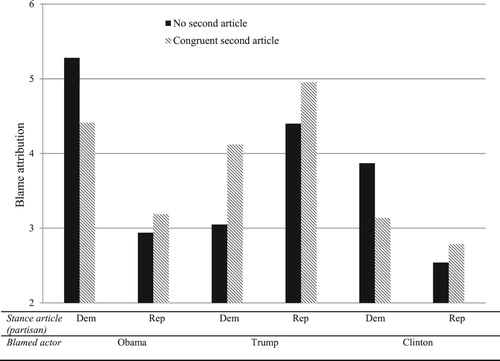
Table 2. The effects of forced and selective exposure to fact checkers of (in)congruent partisan news on blame perceptions.
If we compare the forced-congruent with the selective-congruent conditions (), we can observe that allowing the choice to opt-out of a second article does not influence the selective attribution mechanism. Republicans for example absolve Trump of blame when exposed to a congruent article followed by a challenging second article (M = 3.18, SD = 1.99), and were equally likely to do so when they could avoid this second article (M = 3.06, SD = 1.92). The same pattern was found for the other actors. The difference in responsibility attributions based on exposure to a second article in the form of a fact checker was similar for forced and selective exposure. The freedom of selection or exposure of a second article did not affect its persuasiveness.
In support of H4, partisans strategically use the option to select a fact checker as a cue to confirm or reinforce their prior attitudes. Within the selective exposure condition, people who expose themselves to a congruent fact checker, refuting Democratic partisan news, attribute more blame to Obama (M = 5.06 SD = 1.69) than people who avoid such a fact checker (M = 4.50, SD = 2.01). Likewise, people who select a congruent fact checker refuting Republican partisan attribute less blame to Obama (M = 2.94, SD = 1.72) than those who avoid such a fact checker (M = 4.10, SD = 1.91). These patterns of motivated reasoning were also identified for the other actors. In support of H4, fact checkers are used to confirm partisan identities when they are actively selected or avoided. Forced exposure to fact checkers can have a counter-attitudinal effect (H3), making partisans milder in their attributions of blame when the fact checker already defends their prior attitudes.
Results of study 2
Selective exposure and avoidance of fact checkers of partisan climate change news
Applied to the topic of climate change, demonstrates the likelihood of selective exposure or avoidance of retractions of Democratic partisan news (left) and Republican partisan news (right). As can be seen in this table, selective exposure to a second article that retracts Democratic partisan news is significantly more likely for higher educated partisans and partisans that experience a stronger need for factual information. Moreover, in support of H1, selective avoidance of retractions is predicted by the attitudinal congruence of the partisan news story. This means that participants that agreed with the Democratic Party’s framing of the climate change issue (e.g., humans are responsible for causes and solutions) are most likely to avoid a fact checker that debunks the claims made in partisan news (see ). The patterns of selective exposure and avoidance are not identified for fact checkers refuting claims of partisan news that reflects a counter-attitudinal stance on climate change. Against this backdrop, H1 can only be supported in the context of pro-attitudinal Democratic partisan news on climate change.
Table 3. Binary logistic regression model estimating selective exposure and avoidance of fact checkers of partisan news on climate change.
The effects of refuting (In)congruent partisan news on perceptions of responsibility
The second study investigated the effects of forced and selective exposure to partisan retractions on perceptions of treatment responsibility on the issue of climate change policy. As the current heated debates on climate change mainly revolve around the issue of what should be done (or not to be done), we have investigated the effects of retractions on perceptions of responsibility for solving the issue at hand. A first salient finding is that the Democrats mainly entrust their own party in dealing with the issue of climate change, whereas the Republicans point the finger at the Democrats (see ). Hypothesis 2 is largely supported by the data: forced exposure to a second, incongruent retraction of a first congruent news story does not affect participants’ perceptions on treatment responsibility. There is one exception outside of the political realm: corporations are attributed less treatment responsibility when the second article refutes claims made in a congruent pro-climate change story. Specifically, Democratic partisans entrust corporations less in treating the issue of climate change when exposed to the second article that claims that nothing can be done to counter climate change (see Appendix C).
Table 4. The effects of forced and selective exposure to fact checkers of (in)congruent partisan news on accountability.
Regarding the effects of forced exposure to a second article that attacks attitudinally incongruent news, two significant effects can be identified (see and ). Democrats attributed less treatment responsibility to the Republican Party and corporations when exposed to a second article debunking partisan claims denying human interference in climate change. In support of H3, forced exposure to a congruent fact checker resulted in the attribution of less treatment responsibility – people were thus milder in their evaluations of treatment responsibility when offered a fact check compared to the absence of such a congruent retraction.
Figure 3. Treatment attributions in response to incongruent partisan news on climate change policies, followed by the absence or presence of a congruent second article. ‘Dem’ indicates the presence of a Democrats frame, which is incongruent for Republicans. ‘Rep’ indicates a Republican frame, which is incongruent for Democrats.

Selective exposure or avoidance to a second incongruent article only corresponded negatively to treatment responsibility attributed to the Democratic Party. Specifically, Republicans attributed less treatment responsibility to the Democratic party when they selected a second article that attacked their priors (see ). In line with H4, the incongruent fact checker reinforced the belief that the Democrats should not be trusted with solving the alleged (non) issue of climate changed.
Selective exposure to a congruent second article debunking the claims of the first incongruent article shows different patterns of attribution (see ). First of all, Republicans who selected a congruent attack attributed more treatment responsibility to the Republican Party. So, when the fact checker debunked the Democrats’ issue position, Republicans used the cues in the fact checker to emphasize that their party should be entrusted to solve the issue at hand. The Democrats responded in exactly the same way: they trusted the Republican Party less when they selected a second attitudinal-congruent article (see ). This is in line with H4: the information in the fact checker was used to reinforce partisans’ prior attitudes.
The pattern is different for treatment attributed to the Democratic Party (see ). Republicans attributed more treatment responsibility to the Democrat Party after selecting a second congruent article that debunks pro-climate change news. This does not support H4: they did not use the fact checker to reinforce their prior attitudes, but rather shifted responsibility to the party that ‘owns’ the issue of climate change.
Discussion
Today’s online fragmented and choice-driven media setting may present people with both incongruent and congruent news content – for example in the form of political fact checkers in response to congruent or incongruent partisan news (e.g., Thorson, Citation2016). In the changing role of information in today’s society, assumptions about trueness can shift with time and interpretation. In this setting, this paper relied on two experiments to assess how citizens evaluate responsibility in response to partisan political news – either followed by a congruent or incongruent fact checker, and either presented to them in a selective or forced exposure media environment.
The key findings indicate that citizens’ evaluations of blame are unaffected by forced exposure to a second article that refutes the claims made in a first attitudinal congruent article. This supports the mechanism of motivated reasoning (Taber & Lodge, Citation2006). The first article affirmed people’s prior attitudes, making them resistant to persuasive attacks stemming from a second incongruent article, even in the form of an objective fact checker. As postulated in previous research, citizens indeed evaluate blame in a biased way congruent with in-group membership (e.g., Tilley & Hobolt, Citation2011). Moreover, conflicting facts may be accepted by partisans, but it is the actual partisan interpretation of these facts that matters for opinion formation (Gaines et al., Citation2007). Partisans stick to their guns and filter out incongruent cues offered in the second article (e.g., Iyengar & Westwood, Citation2015).
If the second article was congruent, and the first article incongruent, partisans are actually lowering their guards. This means that the ‘softer’ the summed attack on partisans’ prior attitudes, the less defensive their stance needs to be (Hart et al., Citation2009). In that sense, the results of this study confirm the mechanism of in-group serving bias in motivated reasoning: the second article is judged on its resonance with prior held beliefs. If it offers an attack, it needs to be rejected, and if it offers a confirmation, the defensive stance can be lowered. It needs to be noted that the explanation relying on the mechanisms of motivated reasoning is based on assumptions as this study did not explicitly measure the underlying processes.
In light of selective exposure, we found that partisans selected a congruent article to reinforce their priors and avoided incongruent articles that attacked their partisan views. When having the option, partisans thus use the high-choice media environment to selectively tune in or out a second media option – depending on their prior attitudes. In the democratic setting of assigning responsibility, this study thus shows that the attribution of responsibility can be driven by selective exposure to media cues. People do not necessarily assign blame to be accurate, but rather to confirm their partisan identification (Tilley & Hobolt, Citation2011). This is in line with the findings of Bisgaard (Citation2015). Partisans may be unable to deny certain facts, but they do selectively attribute blame for these facts. If they support the government, they absolve it of blame. If they oppose the government, they hold them accountable.
The results indicate that causal responsibility and treatment responsibility result in different patterns of in-group serving bias. In the second experiment, we offered participants the choice to select or avoid a second article that rebutted claims made in partisan news on climate change policies. After exposure, participants had to assign treatment responsibility to different actors. In this setting, the results indicate that partisans of the Democratic Party are more likely to entrust their own party with treating the salient issue of climate change. Republican partisans also attributed treatment responsibility to the Democratic Party, but only when a second congruent fact-checker was selected.
The findings of this paper have important implications for the democratic principle of accountability in the current media environment of high-choice and information overload. Citizens selectively exposure themselves to as much congruent and reaffirming information as they can, in order to shift blame to the ‘culpable other’. At the same time, when they are not able or willing to avoid attacks on their priors (Garrett, Citation2009), they process the counter-attitudinal information in a way that is congruent with their priors. If the incongruent article attacks their party, they do not align their blame perceptions. If the second congruent article absolves their own party of blame, however, they shift less blame to the other party compared to when the second article blames ‘their’ partisan in-group. They are thus more likely to defend their in-group when it is attacked by the information environment compared to when it is protected.
Although this research has provided important insights into how blame is attributed in a high-choice media environment, the experiments do have some limitations. First of all, this study relied on a single message design that forcefully exposed participants to the first message in an artificial way. Thus, we only offered participants the option to self-select the second article, after being forced to see a congruent versus incongruent first article. In their everyday media environment, they can also have the choice to select or avoid a first article. Moreover, attitudinal congruence was always mixed: the second article either confirmed or rejected the first article and the other way around. Also, as we did not included people with a moderate attitude on the political issues, it would be interesting for future research to investigate how these moderates respond to exposure to cross-cutting information. However, the main aim of this research was to assess responses to cross-cutting information, which may actually be an important part of citizens’ daily media diet. Another limitation concerns the focus on a single country. Future research should investigate how the perceptual screens, selection and avoidance biases play out in the context of other countries, for example those with multi-party systems or those with different salient debates that form the input for political decisions on responsibility. It needs to be noted that the comparison of the different selective exposure groups is not based on a random allocation to conditions, but rather a consequence of selection behaviour. However, we do find similar results for the randomized forced exposure conditions when we take attitudinal congruence into account, which indicates that the findings of the forced exposure conditions tap into similar mechanisms of attribution. In addition, the selective exposure conditions are more externally valid, as they are able to demonstrate which groups of citizens would avoid attacks on their priors if they get the opportunity to do so.
Finally, asking people for assigning treatment responsibility does not have real-life consequences, and people may easily shift treatment responsibility to opposing partisans without binding consequences. Yet, we believe that the mechanism of selective attribution works in the same way as causal attributions of responsibility. Partisans may interpret factual information differently, assigning treatment responsibility in line with their partisan lenses. Yet, future research may rely on more specific measures of treatment responsibility (i.e., by mentioning specific actions and consequences) connected to real-life consequences to better assess the effects of cross-cutting exposure on treatment responsibility.
Despite these limitations, we consider this research as an important step towards a more refined understanding of how citizens navigate through their daily media environment to arrive at their political decisions, indicating that cues offered by the media are processed in a way that is congruent with their partisan identities.
Disclosure statement
No potential conflict of interest was reported by the authors.
Notes on contributors
Michael Hameleers is Assistant Professor in Political Communication at the Amsterdam School of Communication Research (ASCoR), Amsterdam, The Netherlands. His research interests include populism, framing, (affective) polarization and the role of social identity in media effects.
Toni van der Meer is an assistant professor of Corporate Communication at the Amsterdam School of Communication Research (ASCoR) at the University van Amsterdam. His current research focuses on crisis communication, the process of media and public framing of issues, mediatization, and misinformation.
References
- Bennett, W. L., & Iyengar, S. (2008). A new era of minimal effects? The changing foundations of political communication. Journal of Communication, 58, 707–731. doi:10.1111/j.1460- 2466.2008.00410.x doi: 10.1111/j.1460-2466.2008.00410.x
- Bisgaard, M. (2015). Bias will find a way: Economic perceptions, attributions of blame, and partisan-motivated reasoning during crisis. The Journal of Politics, 77(3), 849–860. doi: 10.1086/681591
- Druckman, J. N., & Bolsen, T. (2011). Framing, motivated reasoning, and opinions about emergent technologies. Journal of Communication, 61(4), 659–688. doi: 0.1111/j.1460-2466.2011.01562.x doi: 10.1111/j.1460-2466.2011.01562.x
- Gaines, B. J., Kuklinski, J. H., Quirk, P. J., Peyton, B., & Verkuilen, J. (2007). Same facts, different interpretations: Partisan motivation and opinion on Iraq. The Journal of Politics, 69(4), 957–974. doi: 10.1111/j.1468-2508.2007.00601.x
- Gallup. (2016). Party Affiliation. Retrieved from http://news.gallup.com/poll/15370/party-affiliation.aspx
- Garrett, R. K. (2009). Politically motivated reinforcement seeking: Reframing the selective exposure debate. Journal of Communication, 59, 676–699. doi: 10.1111/j.1460-2466.2009.01452.x
- Gomez, B. T., & Wilson, J. M. (2008). Political sophistication and attributions of blame in the wake of hurricane Katrina. Publius: The Journal of Federalism, 38(4), 633–650. doi: 10.1093/publius/pjn016
- Hart, W., Albarracín, D., Eagly, A. H., Brechan, I., Lindberg, M. J., & Merrill, L. (2009). Feeling validated versus being correct: A meta-analysis of selective exposure to information. Psychological Bulletin, 135(4), 555–588. doi: 10.1037/a0015701
- Hobolt, S. B., & Tilley, J. (2014). Blaming Europe? Responsibility without accountability in the European Union. Oxford: Oxford University Press.
- Iyengar, S. (1991). Is anyone responsible? How television frames political issues. Chicago and London: The University of Chicago Press.
- Iyengar, S., & Hahn, K. S. (2009). Red media, blue media: Evidence of ideological selectivity in media use. Journal of Communication, 59(1), 19–39. doi: 10.1111/j.1460-2466.2008.01402.x
- Iyengar, S., & Westwood, S. J. (2015). Fear and loathing across party lines: New evidence on group polarization. American Journal of Political Science, 59(3), 690–707. doi: 10.1111/ajps.12152
- Malhotra, N., & Kuo, A. G. (2008). Attributing blame: The public’s response to Hurricane Katrina. The Journal of Politics, 70(1), 120–135. doi: 10.1017/S0022381607080097
- Nyhan, B., & Reifler, J. (2010). When corrections fail: The persistence of political misperceptions. Political Behavior, 32(2), 303–330. doi: 10.1007/s11109-010-9112-2
- Stroud, N. J. (2008). Media use and political predispositions: Revisiting the concept of selective exposure. Political Behavior, 30, 341–366. doi: 10.1007/s11109-007-9050-9
- Taber, C. S., & Lodge, M. (2006). Motivated skepticism in the evaluation of political beliefs. American Journal of Political Science, 50(3), 755–769. doi:10.1111/j.1540- 5907.2006.00214.x doi: 10.1111/j.1540-5907.2006.00214.x
- Thorson, E. (2016). Belief echoes: The persistent effects of corrected misinformation. Political Communication, 33, 460–480. doi: 10.1080/10584609.2015.1102187
- Tilley, J., & Hobolt, S. B. (2011). Is the government to blame? An experimental test of how partisanship shapes perceptions of performance and responsibility. The Journal of Politics, 73(2), 316–330. doi: 10.1017/S0022381611000168
- Van Aelst, P., Strömbäck, J., Aalberg, T., Esser, F., de Vreese, C. H., Matthes, J., … Stanyer, J. (2017). Political communication in a high-choice media environment: A challenge for democracy? Annals of the International Communication Association, 41(1), 3–27. doi: 10.1080/23808985.2017.1288551
Appendices
Appendix A. Stimuli (online news story followed by fact checker)
Study 1 (Anti-Democrat framing immigration)
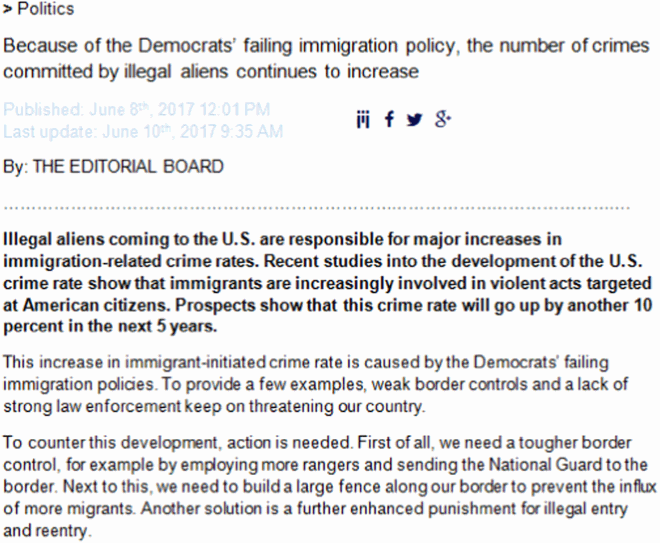
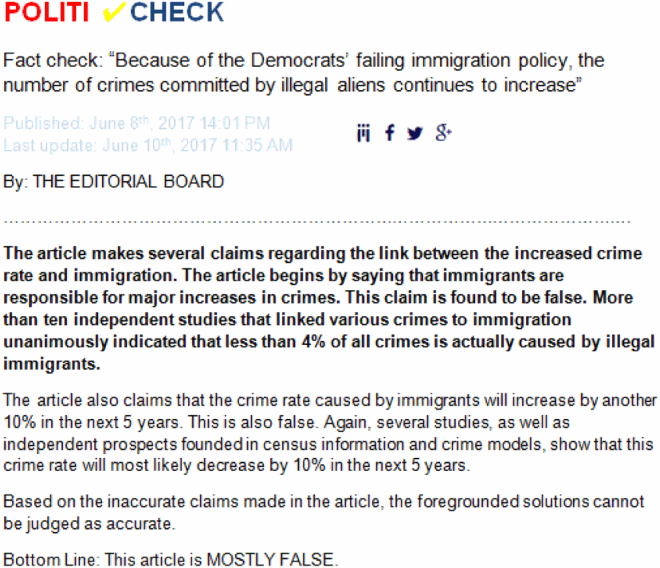
Study 1 (Anti-Republican framing immigration)
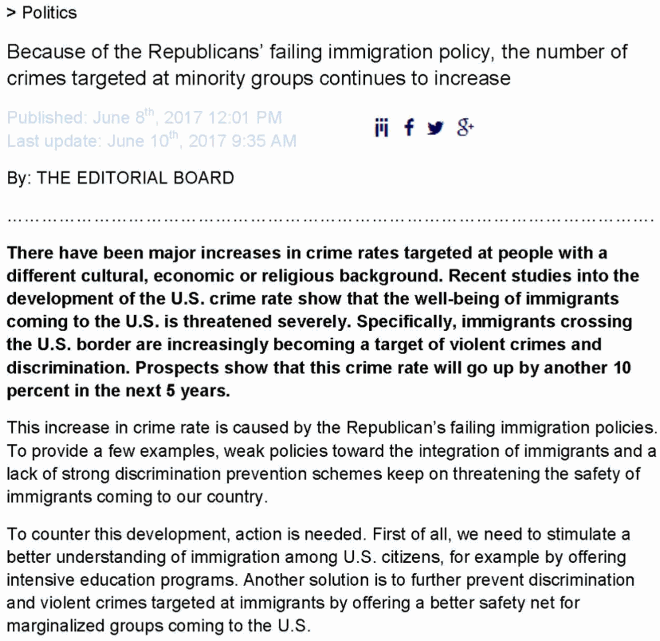
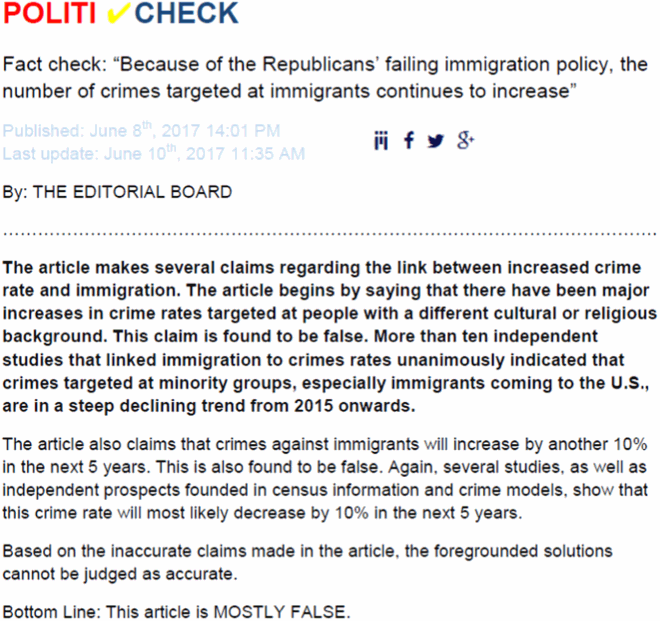
Study 2 (Anti-Republican framing climate change)
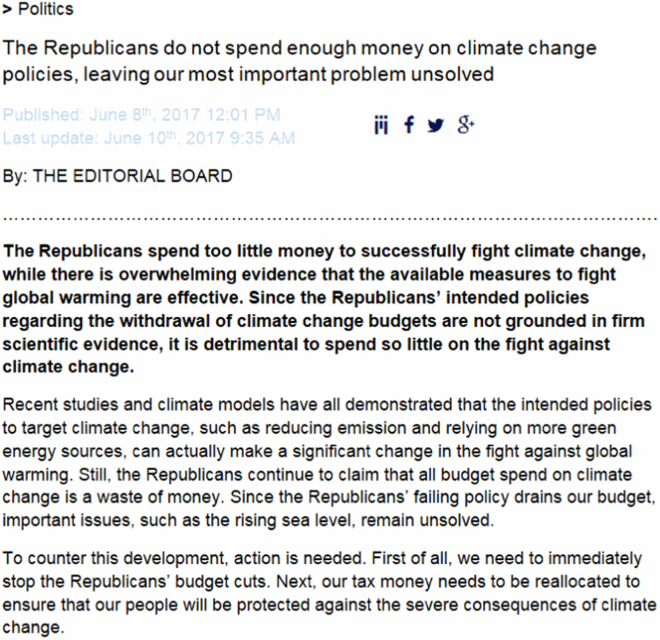
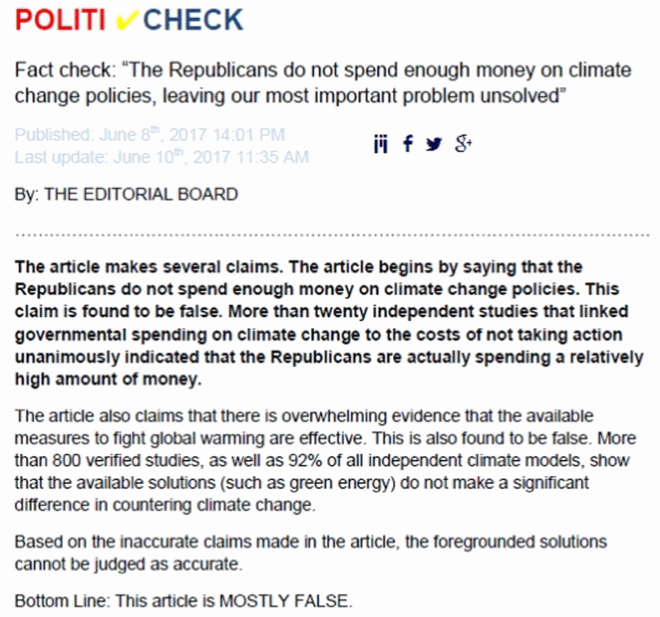
Study 2 (Anti-Democrat framing climate change)
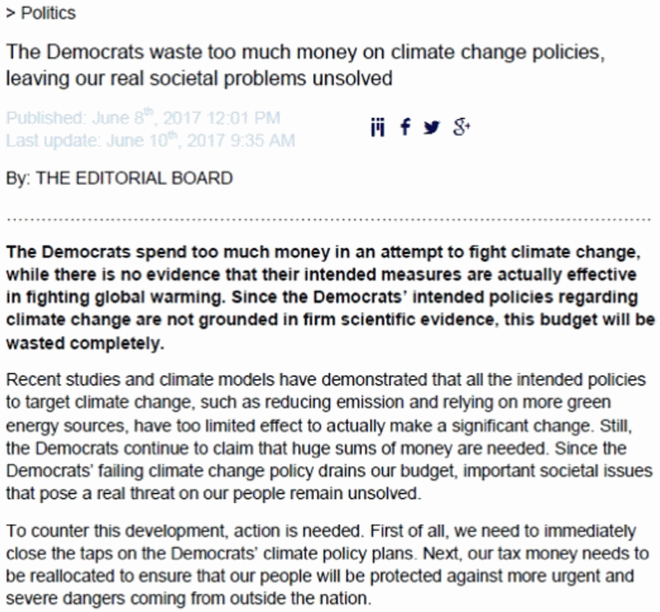
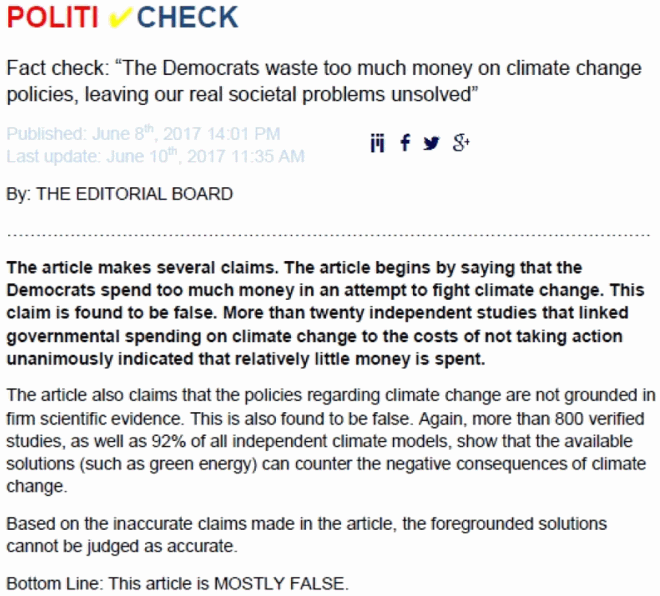
Appendix B. Measurement instrument
Item wording measures causal attributions of responsibility (Study 1)
- Could you indicate to what extent you believe the following actors are responsible for problems related to immigration policies? (1 = not responsible at all, 7 = fully responsible)
U.S. citizens in general
U.S. citizens who identify themselves as Republicans
U.S. citizens who identify themselves as Democrats
The Democrat Party
The Republican Party
Immigrants themselves
Barack Obama
Donald Trump
Hillary Clinton
Law enforcement
The dependent variable was also measured at a later point in the survey, using different item wordings stronger related to the content of the newspaper articles (analyses revealed similar effects as reported in the paper).
Could you also indicate to what extent you believe the following actors are responsible for the development described in the article you just read? (1 = not responsible at all, 7 = fully responsible)
Item wording measures treatment responsibility (Study 2)
- Could you also indicate to what extent you believe the following actors are responsible for offering solutions to fight global warming? (1 = not responsible at all, 7 = fully responsible)
U.S. citizens in general
Experts
Corporations
The Democrat Party
The Republican Party
Scientists in general
Independent scientists
Donald Trump
Non Governmental Organizations (NGO's)
People all over the globe
International politics
Similar to Study 2, the dependent variable was also measured at a later point in the survey, using different item wordings stronger related to the content of the newspaper articles (analyses revealed similar effects as reported in the paper).
Could you also indicate to what extent you believe the following actors are responsible for dealing with the development described in the article you just read? (1 = not responsible at all, 7 = fully responsible
Measures attitudinal congruence
Study 1: Before we proceed with the survey, we want to ask you about your opinion on the issue of migrants coming to the United States. On a scale from 1 to 7, please indicate how strongly you support or oppose that immigrants are entering the United States?
Study 2: Before we proceed with the survey, we want to ask you about your opinion on the issue of climate change policies in the United States. On a scale from 1 to 7, please indicate how strongly you support or oppose the position that Earth is warming due to human activity, and that we need to take immediate action to counter this development?
Survey Flow
